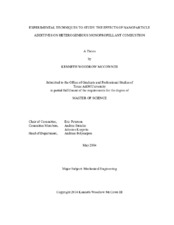| dc.description.abstract | This thesis presents the development of techniques used to investigate the combustion behavior of liquid monopropellants with or without additives, with a focus on nano-scale particles as burning rate modifiers in nitromethane. The linear burning rates of these mixtures were measured in a constant-volume system at chamber pressures ranging from 3 to 14 MPa, all without direct observation of the propellant burning front. Distinct differences in burning rates were observed between burns using a quartz-lined cavity and those employing plain carbon steel. Several analytical models and numerical approximations were used to estimate the temperature profiles of quartz, steel, and layered strand burner tubes, indicating that the higher burning rates measured in the steel cavity were likely caused by a combination of heat transfer and catalytic effects. The close match between the burning rates of neat nitromethane gathered in this study and those taken from recent studies utilizing optical systems proves the utility of the author’s method, while the consistently measured burning rates of the various nitromethane-based nanofluids prove the versatility of the same method when extended to tests on suspended-particle mixtures.
Nano-scale aluminum was used to increase the overall energy density of propellant mixtures, fumed silica powder was used to increase the mixture thickness and encourage aluminum suspension, and nano-scale titania was also included based on its previous use as a burning rate modifier in solid propellants. The silica loading was varied from 1% to 3% by weight, aluminum loading was varied from 5% to 13.5% by weight, and titania was added at 1% by weight. A comprehensive settling study was used to characterize the stability of numerous propellant mixtures, quantifying the particle settling rates of unstable mixtures while subsequently eliminating this instability from all burned configurations. This thesis observed a wide variety of particle effects on the combustion behavior of nitromethane; some of these trends were previously observed by other research groups, while several burning rate effects were observed by the current author for the first time. These novel behavioral trends included an increase in propellant pressure sensitivity over the tested 3- to 14-MPa range for mixtures that included 3% silica by weight, and an even more dramatic increase in pressure sensitivity and linear burning rates was observed only at chamber pressures above 8 MPa for propellants that included 1% titania by weight without silica. The various performance trends uncovered and techniques developed through this study have already been applied to new mixtures based on more exotic compounds, utilizing the lessons learned herein as a springboard to greatly expand the range of propellants currently tested at Texas A&M University. | en |


